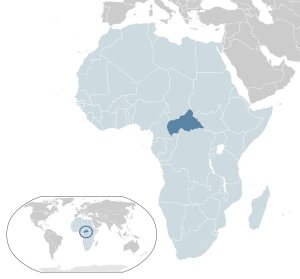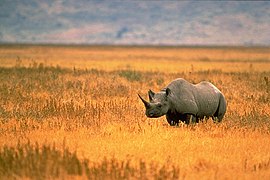Wildlife of the Central African Republic

The wildlife of the Central African Republic is in the vast natural habitat in the
Realizing the serious threat to the wildlife, the colonists – French administration – in 1935 and later the government of the CAR, enacted laws and created national parks and preserves, which covered 16.6% of the country. The three most coveted national parks are the
However, the legal instruments were not effective in controlling poaching activities for profits, as institutional support for protected areas has all along been weak with hunters and loggers not letting go their activities even in national parks. Most of the timber extracted from the CAR is exported to Europe.[2]
Situated in the east of the CAR, Chinko is one of the region's only remaining strongholds for numerous species including the highly threatened
The richness of the wildlife of the Central African Republic is reflected in its about 3,600 species of plants, 663 birds, 209 mammals (includes two endemic species and 11 threatened species[5]), 187 reptiles and 29 amphibians.[2]
Geography
The Central African Republic, a landlocked country in Africa, which was once a French colony under the name Ubangi-Shari, is a rich rainforest area of 22.755 million ha with tropical forest covering 35% of the area of the country.[2] The rich forests of the Central African Republic vary and largely are delimited within the major tropical rain forests of Africa and the great open savannas that stretch across the continent, south of the Sahara. Depending on climatic conditions, it is distributed with thick forests in the south, woody savanna in the center and grasslands in the north. Wildlife in these forests reflect all the species identified in Africa; the most conspicuous species include elephants, chimpanzees, crocodiles, hippos and giraffes.[3][6]
The ecosystem in Central African Republic consists of the Western Congo Basin Forests, the Northeastern Congo Basin Forests and the Sudanian Savannas. The land use is categorized under the grass and shrub as 59%, under crops and settlements at 5% and major forests at 36% of the total land area of the country. Anthropological pressure is reported to be low in 46% area; medium in 44% and high in 10% of the land area.[5]
Apart from all the savanna species of wild animals, the unique species found here are forest gorillas.[6]
It had recorded the least percentage of
Manovo-Gounda St. Floris National Park
Manovo-Gounda St. Floris National Park is a national park and
Dzanga-Sangha Special Reserve

Dzanga-Sangha Special Reserve is a protected reserve of southwestern Central African Republic was established in 1990 and covers 6,865.54 km2 (2,650.80 sq mi).[9] The forest special reserve was established in 1990 along with its neighbouring Dzanga Ndoki National Park. Until 1986, anybody was free to shoot game in the forest.[10]
The reserve is ecologically rich and contains a variety of
Chinko Project
Situated in east CAR, the Chinko Project provides a rare sanctuary for wildlife in a volatile region plagued by militarised ivory poachers and excessive cattle farming. Extreme poverty has resulted in a 95% depletion of all wildlife, making this one of the most crucial conservation projects on the continent. There are very few places on earth quite like Chinko. This landscape, comprising both tropical rainforest and savannah plains, is home to ten species of primate, two distinct types of elephant and the iconic Lord Derby eland.
Legal ordinances
To preserve the unique forest vegetation that covers 35% of the land area of the country and the wildlife within it, and put an end to the intensive poaching activity from across its international border with Chad and Sudan, establishment of national parks and reserves to preserve the environment of rich natural heritage became a necessity. The French administration as colonists of the country in 1935 and later the government of the Central African Republic enacted laws to establish national parks, presidential parks, strict nature reserves, wildlife reserves, special reserves and biosphere reserves.[3]
The national parks set up are the
Important ordinances enacted by the Central African Republic concern protection of wild life and regulation of hunting, under the guideline that wild life forms an integral part of the national heritage. The law defines categories of protected areas and prescribed rules for their establishment, apart from the management aspects of fully and partially protected species and ordinary game species; regulation hunting procedures also have been listed for ordinary game species. Hunting of fully protected species is banned. Partially protected species can be taken with specific permission. The capturing and transport of wild animals by and under the control of the Wildlife Department, enforcement measures and penalties are also defined.[13]
Flora
The flora of the Central African Republic has not been very well studied at all, although at least 3600 species are known.[14] However, there are likely to be as many as 5000 species.[14] The country is mainly dominated by Sudanian woodland, although a small area of Acacia dominates the Sahelian woodland in the extreme north. Many of the species which are endemic to the country are located in the hills of northeast, especially in the Massif des Bongos and Massif du Dar Chala in the Yata Ngaya Faunal Reserve area. Notable northern forests include Kotto, Kaga-Bandoro and Nana forest. Savanna reserves in the north are important for large mammals, especially Bamingui-Bangoran National Park and Biosphere Reserve and Manovo-Gounda St. Floris National Park and the north of the country also contains floodplains.[14]
In the southwest is lowland forest and secondary grassland interspersed with forest in the
Woodland savannah mainly consists of
Fauna

The fauna of the CAR consists of 209 mammal species, of which two are endemic and 11 are threatened. The
The southwest has a colourful variety of
Mammals
Mammals are

Breeding of elephants in the dry months of December to March and July and August has interesting aspects. Males are said to be in
As of 1990, the country had about 1,500 giraffe and 8,000 buffalo in the
The country has 23 species of
- Carnivores
Carnivores reported are:
- Rodents
Rodents include
Reptiles
Reptiles of the Central African Republic as listed in the laws of the land are:
Bats and birds
The CAR forests includes lesser woolly bat (Kerivoula lanosa), Veldkamp's bat (Nanonycteris veldkampii), grey parrot (Psittacus erithacus), African fish eagle (Haliaeetus vocifer), grey-cheeked hornbill (Bycanistes subcylindricus), shoebill (Balaeniceps rex), yellow-fronted canary (Serinus mozambicus), Dzanga robin (Stiphrornis sanghensis), Hartlaub's duck (Pteronetta hartlaubii), ostrich (Struthio camelus), little grebe (Tachybaptus ruficollis), pelican, cattle egret (Bubulcus ibis), hamerkop (Scopus umbretta), saddle-billed stork (Ephippiorhynchus senegalensis), yellow-billed stork (Mycteria ibis) and raptors and water birds.[13][19][20][21] In the Manovo-Gounda St. Floris National Park 379 species of birds have been sighted, which can be seen from observation platforms built in the park or by taking a boat ride on the Sangha River or its tributary, the Mossapoula River.[23]
Insects
- Lepidoptera
Conservation
There was a time when Central African Republic was given the epithet "an animal paradise". However, in centuries this situation changed even though several parks and reserves were created. As a result of uncontrolled poaching, the number of elephants dropped from 100,000 to less than 10,000 and the rhinoceros almost disappeared.[25]
To conserve the rich wildlife resources of the Central African Republic has become a major concern, in spite of establishing, with legal ordinances, national parks and game reserves. The main reasons for this has been the vastness and impoverished status of the country as a whole. However, the effectiveness of wildlife crime law enforcement appears to be working now with the Central African Ministry of Water and Forests and the Central Police, with technical support from international environmental organizations such as WWF playing an effective role, to punish high-level traffickers with penal servitude and fines; a case cited is of a trafficker sentenced to a jail term of six months and a fine.[26]
In conservation efforts, the WWF has persuaded the
The forest department of Central African Republic has introduced new forest codes in 2008 to ensure better management of resources on a sustainable basis to regulate and preserve biodiversity/ The goal is to balance growth and employment requirements with attention to check desertification. Under the new laws, border control inspectors with mobile squads have been introduced to check the movement of lumber crossing the nation's borders, enhance revenues from forestry with cognizance of the forestry and wildlife sources of the country. A financial mechanism has also been introduced at a communal level for local management of money.[28]
Gallery
-
Chimpanzees in Central African Republic
-
African wild dog in Central African Republic are estimate only for 150 individuals
-
Transportation of logs
References
- ^ a b c "Has the final countdown to wildlife extinction in Northern Central African Republic begun?" (PDF). Africa Journal Ecology:Blackwell Publishing Ltd. 2009. Retrieved 21 April 2011.
- ^ a b c d e "Central African Republic". mongabay.com. Retrieved 21 April 2011.
- ^ a b c d e "Parks, Reserves, and Other Protected Areas in Central African Republic". Parks.it. Retrieved 21 April 2011.
- ^ a b "Brief Description". unesco.org. Retrieved 21 April 2011.
- ^ a b c "Animal Info – Central African Republic". animalinfo.org. Retrieved 22 April 2011.
- ^ a b Thomas O'Toole (1986). The Central African Republic: the continent's hidden heart. Westview Press. Retrieved 21 April 2011.
- ^ "World Heritage Nomination – Iucn Summary 475: Parc National Du Manovo-Gounda-St Floris (Central African Republic)" (PDF). unesco.org. Retrieved 21 April 2011.
- ISBN 978-0-313-33203-6. Retrieved 23 April 2011.
- ^ "Dzanga-Sangha Special Reserve". World Database on Protected Areas. Retrieved 18 September 2010.[permanent dead link]
- ISBN 0-691-12219-9.
- ^ "Central African Republic". Africa's Eden. Archived from the original on 27 March 2010. Retrieved 18 September 2010.
- ^ Kamiss, Amis; Turkalo, Andrea K. (1999-11-30). "Elephant Crop Raiding in the Dzanga-Sangha Reserve, Central African Republic" (PDF). The African Elephant Specialist Group (AfESG).
- ^ ISBN 978-2-88032-091-1. Retrieved 22 April 2011.
- ^ ISBN 978-2-8317-0021-2. Retrieved 23 April 2011.
- ^ "Report and Recommendation of The President of the International Development Association to The Executive Directors on a Proposed Development Credit in an Amount Equivalent to SDR 14.5 Million to The Central African Republic fora Natural Resource Management Project" (PDF). World Bank. 11 April 1990. Retrieved 22 April 2011.
- ^ "The Dzanga-Sangha Rainforest". American Museum of Natural History. Archived from the original on 3 April 2009. Retrieved 18 September 2010.
- ^ Curran, Bryan K. "Strategic Planning For Conservation Management Options In The Lobeke Region, Southeastern Cameroon". World Wildlife Fund. Retrieved 18 September 2010.
- ^ "The making of a rainforest". Natural History.
- ^ a b c d e "Information". Animal Diversity Web: University of Michigan Museum of Zoology. Retrieved 21 April 2011.
- ^ a b c d e "Information". Animal Diversity Web: University of Michigan Museum of Zoology. Retrieved 21 April 2011.
- ^ a b c d e "Information". Animal Diversity Web: University of Michigan Museum of Zoology. Retrieved 21 April 2011.
- ISBN 978-0-7614-7306-0. Retrieved 23 April 2011.
- ^ a b c d e "Western Lowland Gorillas". africas-eden.com. Archived from the original on 2011-09-09. Retrieved 21 April 2011.
- ^ "Manovo-Gounda St Floris National Park (1988):Central African Republic". Heindorffhus. Retrieved 22 April 2011.
- ISBN 978-0-8108-4913-6. Retrieved 22 April 2011.
- ^ "Central African Republic Govt hits back at poachers". African Conservation Foundation. Retrieved 22 April 2011.
- ^ "WWF in the Congo Basin: Working with the BaKa". World Wildlife Fund. Archived from the original on 2007-10-31. Retrieved 22 April 2011.
- ^ International Monetary Fund (2009). Central African Republic: Poverty Reduction Strategy Paper – First Progress Report. International Monetary Fund. pp. 49–. GGKEY:SN79NQY7SF5. Retrieved 22 April 2011.






